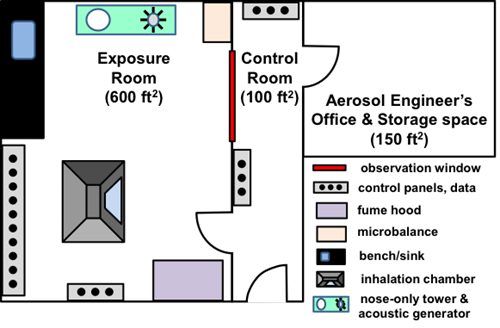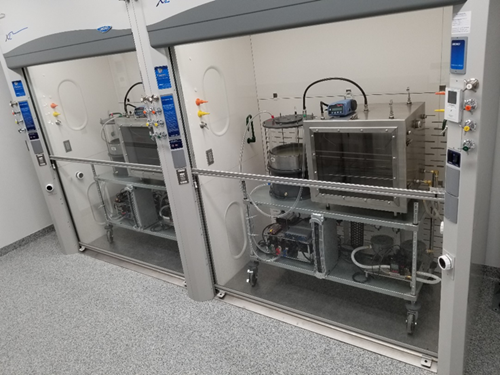CRRF Facilities
WVU Health Sciences Center – INHALATION FACILITIES
Overview
The WVU Health Sciences Center houses two Inhalation Facilities, for which Dr. Tim Nurkiewicz serves as the Director. The purpose of these facilities is to expose rats and mice to xenobiotic aerosols, to directly assess cardiopulmonary toxicities. The original facility was designed and built in 2008; with a second, larger facility completed in September of 2017. These facilities have already resulted in publications on nearly 20 different materials, including silica, graphene, mountain-top mining particle pollution, hydraulic fracturing platform particle pollution, and 3D printer additive emissions.
Rodents are exposed to various aerosols in whole-body exposure chambers or nose-only exposure systems. Aerosols are generated by patented devices developed at West Virginia University (Nanoparticle Aerosol Generator: U.S. Patent #8,881,997. 2014), and the National Institute for Occupational Safety and Health (Acoustical Generator: U.S. Patent, #8,875,702. 2014). The method of exposure is dependent upon the amount of bulk materials available for aerosolization. Exhaust from the facility is piped through a five-stage low pressure filter also housed with this equipment. Aerosols are characterized in real-time, and tightly controlled to ensure rigor and reproducibility. Because of the collective technical capabilities present in the Inhalation Facility, nearly any particle may be aerosolized. Up to six agents/exposures can be tested at a single time.
Original Inhalation Facility
The original inhalation facility comprises approximately 600 square feet, with capacity for approximately 16 rats or 50 mice.

Inhalation Facility 2.0
Inhalation Facility 2.0 is a free-standing facility with dedicated HVAC, electrical, emergency power, and plumbing systems. It comprises approximately 2200 square feet, with capacity for approximately 140 rats or 400 mice across six exposure hoods. This multiple-hood setup allows for simultaneous execution of multiple research projects. Inhalation Facility 2.0 includes dedicated rooms for nanomaterial exposure, cigarette/vape exposure, and engine emission exposure.

